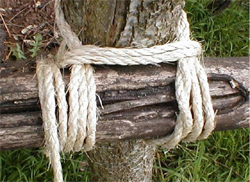
Introduction
A lashing is a means of fastening two poles (or spars) together. There are many lashings, each of which is designed to do a particular job depending upon what use you put the poles to.
Lashings form a very important part of pioneering and if you wish to construct any pioneering project you will need to have tried and practiced at least the first three lashings on the list.
It is important that you choose the correct lashing for the job. Look at the angle the poles cross. Are they touching each other? Where will the strain be on the poles? What are you using the poles for? What type and length of rope will you need?
No matter what lashing you decide upon it is important that you tie it correctly, neatly and securely. Make sure that all the turns are tightened as you go, don't let the rope slack off or, at best, you will lose strength in the lashing and at worst your construction will apart around your ears! If you need to get extra purchase on the rope ask a friend to help or use a Marlingspike hitch to attach a temporary handle to pull on.
A Diagonal Lashing is used for securing diagonal braces to hold a structure rigid.
A Figure-of-eight Lashing is a variation on the Sheer Lashing.
The Filipino Lashing is a quick alternative to the Diagonal Lashing.
The Japanese Lashing is a quick alternative to the Square Lashing.
A Sheer Lashing is used to bind adjacent poles together.
A Square Lashing is used to hold two poles at a 90-degree angle to one another.
